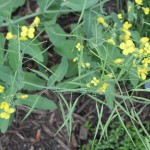 During May, 2015, the Garden State on Your Plate program of the Princeton School Gardens Cooperative hosted radish tastings on Wednesdays in the four elementary schools. Since I am the school garden educator for two of those schools, I had the chance for some garden serendipity, tying in our school garden radishes to the radishes being experienced in the cafeteria.
During May, 2015, the Garden State on Your Plate program of the Princeton School Gardens Cooperative hosted radish tastings on Wednesdays in the four elementary schools. Since I am the school garden educator for two of those schools, I had the chance for some garden serendipity, tying in our school garden radishes to the radishes being experienced in the cafeteria.
It began with an email from Fran McManus with an idea for planting radish seeds in transparent containers, which would allow students to observe the development of both the root—the radish—and the leaves. My sister had donated a bunch of transparent plastic gelato containers, so I had Community Park School third graders fill them with potting mix, then carefully plant radish seeds adjacent to the outer walls, so we could watch them grow. As an added bonus, we planted half purchased seeds, and the other half were seeds saved by Kindergartners from the Community Park garden itself, to see which would grow better.
By the time we planted the radishes in the jars, there were already Kindergarten radishes coming along nicely in one of the Community Park beds.
I checked both the jarred radishes and the garden bed radishes a couple days before the tasting. The jarred radishes showed nary a sign of any radish root development, just some disappointing white roots. The gardened radishes were reaching the point of woodiness, but they were lovely on the outside, and some were developing flowers, which, I knew from talking with Charlie Thomforde, the wonderful Trent House gardener, would soon turn into sweet little radish pods, tasty if we got to them before they fully went to seed.
So, on radish tasting day, all the Kindergartners met out in the garden to pick three radishes, one for each class to present to Joel Rosa, Nutri-Serve food service director for PPS. Why only three? I explained to the kids that I wanted the rest to go to pods, which we could pick.
He was wonderful with the kids, and was duly impressed when he learned that we were planning to eat radish pods soon.
A week or so later, radish tasting came to Littlebrook School, my other K-5 school. I was so excited on that day to discover that our forage radishes, which fourth graders had planted as part of a cover crop mix (more on that another time) were going to lovely delicate pods.
All three fourth grade teachers responded enthusiastically to my request to bring their classes out for a brief picking and tasting of pods.
I asked the students to answer three questions:
- Did the pods taste like the radishes they had tasted earlier that day in the cafeteria?
- If so (or even if not), were the pods milder or spicier than the radishes they had already tasted?
- If not like radishes, what did the pods taste like?
Very few students—or I, for that matter—actually thought the pods tasted like radishes. Everyone thought they were milder. Many students thought the pod tasted like a mini green bean or a pea pod. I can’t remember all the other answers.
The garden is nothing if not a place for serendipity!

 Last month, in recognition of Farm-to-School month, the Community Park PTO held its first-ever “Help Our Garden Grow” Day. It was an overwhelming success, as more than 20 families around the community showed up to volunteer. As they soaked in the sunshine, these parents and students installed two new gorgeous raised beds, cleaned and mulched existing beds, expanded two gardens in the back of the school, painted rain barrels, decorated and hung new signs in each garden, planted several new shrubs and trees, and repaired garden furniture. Mr. Emmons, the school’s science teacher, was delighted with the improvements. As a result of these accomplishments and the CP community’s hard work, he was able to jump into winter garden preparation with his students in late October.
Last month, in recognition of Farm-to-School month, the Community Park PTO held its first-ever “Help Our Garden Grow” Day. It was an overwhelming success, as more than 20 families around the community showed up to volunteer. As they soaked in the sunshine, these parents and students installed two new gorgeous raised beds, cleaned and mulched existing beds, expanded two gardens in the back of the school, painted rain barrels, decorated and hung new signs in each garden, planted several new shrubs and trees, and repaired garden furniture. Mr. Emmons, the school’s science teacher, was delighted with the improvements. As a result of these accomplishments and the CP community’s hard work, he was able to jump into winter garden preparation with his students in late October.